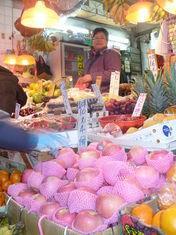
The phenomenal growth in Chinese apple production over the last 25 years has made a significant impact on the fresh produce market and turned China into an apple superpower.
The country is a relative newcomer to the apple game as, until the early 1980s, there was no serious commercial production of apples in China.But spurred by agrarian and land-use reforms, and funded in part by the Chinese central government, Chinese growers initiated a massive apple tree-planting programme in the late 1970s.
By the early 1990s, China had overtaken the US as the world’s biggest apple producer, and now the country grows nearly half of all the apples on the planet; over four times more than its nearest rival.
Dr Desmond O’Rourke has been studying the international apple market for more than 30 years as a former member of the agricultural economics faculty at Washington State University and, more recently, as head of Belrose Inc.He outlines the impact this growth has had on the competition. “China is expected to produce 28.5 million tonnesof apples - 43 per cent of theworld’s total of 66.2mt - this year,” O’Rourke explains.“While most of its production is consumed domestically, it is also a major exporter of low-cost, fresh Fuji and cheap concentrated apple juice. It has had a devastating effect on fresh competitors in South East Asia and on apple processors worldwide.”
Setting aside domestic consumption and concentrated apple juice production, the export of fresh apples from China was forecast at 870,000t in the 2008 season. This has actually dropped 15 per cent from the revised estimate of the previous year, as a result of reduced demand due to the worldwide economic slowdown.
Russia is the top export market for Chinese apples.Indonesia, the Philippines, Thailand, Vietnam and Hong Kong are also very important, and there are some sendings to Europe.
Jason Duan works for Jining Brother International Trading in the Shandong province, a key apple-producing area in north-east China. The firm, which supplies Chinese fruits and vegetables including garlic, ginger, onions, potatoes, apples and pears, was established in 2002 and already boasts annual sales volumes of more than $30m (£20m).
Duan explains that the business is now focused on exports of fresh and processed fruit and vegetables, “now that we have won a broad market and steady clients from Europe, the Middle East, South America, South East Asia and Africa”.
A walk through any street market in the bustling streets of Hong Kong supports both O’Rourke’s view about competition in South East Asia and Duan’s claims of rapid growth in export sales. The distinctive Chinese Fuji and Golden Delicious apples outnumber their US competitors on most stalls.
In Hong Kong, domestic production now represents only four per cent of its gross market for fresh produce. At the recent Farm Fest 2009 event, Hong Kong’s Agriculture Fisheries and Conservation Department (AFCD) actively encouraged organic production, specialist crops and Pick Your Own (PYO) initiatives, to help local producers combat the enormous impact of their mighty exporting neighbour, China.
Michael Chang, organiser of Farm Fest 2009 and crop specialist at the Hong Kong AFCD, insists “cheap imports are killing Hong Kong agriculture and traditional methods are no longer profitable - we need to move to speciality produce to survive”.
But it is not just producers in South East Asia who are worried. According to the US apple association, the stateside apple industry is heavily dependent on leading export markets including Canada, Mexico, Taiwan, the UK and Hong Kong. These valuable export markets, particularly those in Asia, are vulnerable to encroachment by the new apple superpower.
Just a few months ago, in November 2008, the US department of agriculture (USDA) published its Global Agriculture Information Network (GAIN) report on deciduous fruit production in China, which carefully documents the dominance of the Chinese apple.
O’Rourke suggests that there are invisible subsidies supporting this dominance. “One of China’s main advantages is its low-cost labour,’ he says. “However, the Chinese apple industry has also benefited from not paying market prices for its land, capital and transportation…
“If China met its full World Trade Organisation obligations, those hidden subsidies would not be possible.”
The USDA GAIN report highlights the fact that production costs in China are rising and this could make life more difficult for the apple superpower in future years. In the Shandong province, the price of fertiliser was rising at 28 per cent in 2006-07 and labour costs are also on the up.
But industry experts cannot agree whether China is a major export opportunity for fresh produce or a major threat. Apple imports into China were forecast at 42,000t in 2008, up six per cent from the revised estimate of the previous year.This supports the popular theory of China as a growing export market for fresh produce, as 200m people move to urban settlements and obtain more consumer spending power.
The reality is that while this year China remains a significant and growing export opportunity for apple producers, next year it will probably send more apples to Bangladesh alone than it imports in total from the rest of the world.
So how do apple producers compete with such a major force? O’Rourke shares a similar view to that of Chang. “In the fresh arena, other producers have been competing by moving rapidly into newer varieties, where China does not have a comparative advantage,” he says. “China has been slow to ramp up new varieties for many reasons.”
But as the Chinese Year of the Ox brings more news of shrinking demand and increasingly price-sensitive consumers, the growth in Chinese apple production is unlikely to continue at the same breathtaking pace.However, the domination of the apple superpower is not likely to diminish and its role on the export stage may well grow larger as the global recession bites, unless competitors can find a powerful defence strategy.



